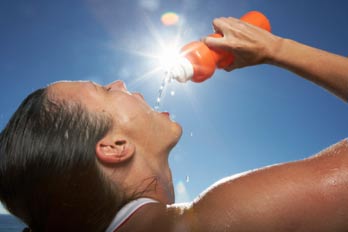 Summer is just around the corner, and temperatures will soon be heating up. Be smart with your training regimen in the hot days of summer to avoid a heat-related injury, some of which can be life threatening. It is especially important to know your training environment here in San Diego where the temperatures during the summer can vary from the 70°-80°s at the coast; 90°-100°s several miles inland and over 110° in the deserts. Not only is the temperature important but also the humidity level, which, again, can be moderate to high near the coast and very low further inland and arid in the deserts.
Summer is just around the corner, and temperatures will soon be heating up. Be smart with your training regimen in the hot days of summer to avoid a heat-related injury, some of which can be life threatening. It is especially important to know your training environment here in San Diego where the temperatures during the summer can vary from the 70°-80°s at the coast; 90°-100°s several miles inland and over 110° in the deserts. Not only is the temperature important but also the humidity level, which, again, can be moderate to high near the coast and very low further inland and arid in the deserts.
Humans have a normal resting core temperature of 98.6°F ± 2°F. For the body to function correctly and survive, this temperature must remain within just several degrees of the normal resting core temperature. If one’s core temperature rises (or decreases) excessively (above 105°), a reduction in physical and cognitive performance is observed. Core temperatures above 105° are considered life threatening and immediate medical assistance is essential.
Core body temperature affects heart rate, blood pressure, cardiac filling and output. Just a 1°F increase in core body temperature increases heart rate by approximately 10 beats per minute. In order not to overheat, your body must regulate and balance how much blood gets used to keep vital organs working and how much gets sent to the surface of the skin to promote cooling. The surrounding environment must be conducive to help cool the skin; this is dependent upon temperature and humidity. If the atmosphere is very warm and humid, cooling of the body’s core temperature becomes more difficult. Your sweat won’t evaporate well in already saturated air, making it more difficult for the body to regulate itself.
When exercising, your metabolism increases causing the body to use more metabolites to feed energy into the working muscles cells. Believe it or not, your muscles will only use approximately 20% of this energy for its cells to function with the other 80% being given off as heat. Your body has three main mechanisms for dispensing this heat into the environment: convection, radiation, and evaporation. Convection is the transfer of heat through either a gas (such as air) or a liquid (such as water). An example of this would be placing your hand in a bucket of warm water or paraffin. Radiation is heat gained or lost, such as warming yourself in direct sunlight or holding your hand near a light bulb that has been on for a while. Evaporation is the vaporization of water (sweat) off the skin’s surface. Evaporation is the body’s most effective way of giving off excess heat and is the most important mechanism for sustaining normal core body temperature during exercise in heat. (Zachazewski, James E.; Magee, David J.; William, Quillen S. Athletic Injuries and Rehabilitation. 1996. pp 263-264.)
Another important factor in body temperature regulation is the consumption of fluids. If sweat output is greater than fluid intake one becomes dehydrated, which will cause one’s heart rate to increase, as well as core body temperature, making training more difficult and even potentially dangerous. To avoid dehydration, drink plenty of fluids prior to activity and during and after activity. If you are excessively sweating over long periods of time, it may also be necessary to increase the intake of salt.
The three most common heat-related ailments are listed below, from least to most severe:
- Heat Cramps: This is a common condition when training in hot weather with prolonged sweating. Prolonged sweating causes a decrease in salt in the body, which, in turn, may lead to cramping of the muscles in the extremities and abdominal region.
- Heat Exhaustion: This is a more serious heat-related illness, which occurs when the cardiovascular system has difficulty balancing blood flow into vital organs and to the skin for cooling, which leads to an increase in core body temperature and skin surface temperature. A person with heat exhaustion may report fatigue, dizziness, nausea, excessive thirst and dry mouth and even confusion. Someone with these symptoms must decrease his/her work load, find a cool place to rest, and consume fluids and salts. If this condition is not treated it can lead to the most severe heat-related illness, heat stroke.
- Heat Stroke: This is an extreme case of heat exhaustion. Body tissue damage occurs due to the increase in core body temperature and requires immediate medical intervention. Hot, dry skin with little to no sweating is common, as is loss of consciousness and mental confusion.
To avoid heat-related illness this summer:
- exercise in the early morning or evening hours when it is cooler.
- wear loose-fitting clothes
- drink plenty of fluids prior to, during and after activity
- add salt if needed to your diet
- check with your MD or pharmacist if taking medication to make sure it won’t interfere with your body’s ability to regulate itself
- exercise at a lower intensity level during very hot conditions
If you have further questions regarding training safely during the hot summer months, please feel free to contact our office to talk with a physical therapist that will help you build a safe and effective exercise program.

